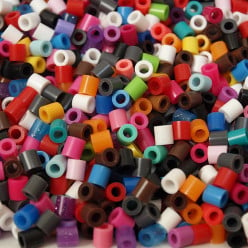Is Adobe Photoshop better than Illustrator?
Hi fellow Hubbers! I'm a graphic designer for an advertising company in Singapore and I've been using Photoshop (CS, CS3 Extended and CS4) for almost 2 years now for most of my work.
Now, I'm beginning to try Illustrator but I don't seem to like it and I think (based on my little experience) Photoshop has all the functions Illustrator has, and even more. So I thought I'll just go back to my friendly Photoshop CS3. But what I don't understand is why are some people using Illustrator?Azhar as they have a saying in the racing industry 'horses for courses'.
I am no expert but as the name would imply Illustrator is mainly for drawing images (vectors) whereas Photoshop as the name implies is mainly for working with images (pixels).
There is some cross-over in each program , so it would depend on what your own use was for each program.
Personally I love Photoshop.
Two different purposes as noted. So I'm missing the question here? Vector graphics and Bitmap graphics have much different uses.
That there is the difference.
Vector vs Raster.
Some amazing illustration work can be done in Illustrator (though I prefer some good old Macromedia Freehand version 8). And when resized, it doesn't lose quality.
But they have two different uses. They can overlap a little. But otherwise Illustrator isn't for editing photos.I think I need to do a bit of research on "Vector" and "Raster"

cheers!
If you have Illustrator or CorelDraw, and also have Photoshop or some other photo editing program, start a new project in each, and use the Text tool and type in a short sentence at 12pt type. Do the same in both programs.
Now zoom in to view the text close up. Illustrator, being primarily a 'vector' drawing will maintain full clarity at any zoom setting. Whereas Photoshop or any (bitmap, or 'raster') photo editing program will go all fuzzy (pixellated) the more you zoom in (depending on the resolution you've chosen).
That should give you an illustrative idea of the difference.Thanks timorous! You've provided a great start with my research. Your example helps to clearly distinguish between raster and vector
 .
.tumorous can u pl tell me which one is better for logo,banner designing.
Use both, as the two programs complements each other. I started using Illustrator about a year ago and I've found it quite useful. The quality of the graphics in Illustrator looks so much better.
I have to agree with this reply. Both have their advantages and they do compliment each other. I frequently create drawings in Illustrator CS5, but do all my cropping of rasterized images in Photoshop. I can load my PS layers in Illustrator and maintain everything I need for a great composition. In my opinion, they both are good at what they do.
Useful information here, I've always wondered the difference, I've only used Photoshop. I find that rendering original art on Photoshop to be difficult. I've tried using Google Sketch Up for this purpose all seems clumsy...
every try to do extensive text layout in Photoshop!
"horses for course" is well saidI think the two programmes have two different uses...photoshop for more creative/ complexing designing and illustrator for intricate detailed drawings.
The main difference is that Illustrator (and CorelDRAW and the like), are vector-based drawing programs. This means that (non-photographic) graphic elements, including text, can be extensively re-sized and retain the same clarity of lines and edges.
I use CorelDRAW for doing layouts. It's much easier to resize rectangles and other non-photo elements without losing quality. Text editing is very flexible. You can of course import bitmap photos as part of the layout. I'm sure Illustrator works the same way.
Whereas Photoshop and other photo-editing programs are bitmap-based. You can't re-size too much without losing quality (blocky pixellation), unless you use a fairly high resolution, i.e. 600 dpi or more.Photoshop is for mainly editing and manipulating artwork that can include Photography, it's a "bitmap" editor, whereas Illustrator is a "Vector" editing software application. It's totally awesome. I just did a hub on Illustrator with an artist, and version 8 is muck compared to the new version. But in the hands of a pro, it can sizzle. Web desingers will - if they do it for a living - use both these packages and an honorable mention for Corel Painter too, as it rocks, and has more paint options than Photoshop. Hope that helps yawl!
I think with illustrator you can do better vectors and there is a big difference in this field.
Use Illustrator for web design such as logos and Photoshop for photo editing.
I have used Illustrator a little bit before when I was taking a graphic arts class, however, I normally only use Photoshop Elements since it's all I own on my laptop and it is GREAT.
i use free or nearly free programs that are similar to Adobe Photoshop.
it doesn't make sense to pay so much for software
These programs have their own specialties and features. There are instances when you need to use photoshop because illustrator doesn't have this feature and vice verse depending on your needs.
Those are 2 programs with 2 different functions
Maybe you work with more imaging jobs, so the illustrator just help you a littleAgreed. The OP is comparing apples to oranges.
I like PS better than Illustrator. I guess it's more about preference.
They are two different software programs for two different things matey. Stick with Photoshop and beware of the content aware function.
Never tried illustrator, I think it's similar to corel draw. eh?
You should ask BP this question. They seem to be doing photo manipulation on every picture they release to the public these days. If only they could spend their resources doing something else...
Sorry, I aint aware what BP stands for :s. care to elaborate ?

Illustrator is a vector based program that does not use pixels whereas photoshop creates with pixels. If your resolution is too low, your image becomes pixelated, which can sometimes happen with text in photoshop. Vector based programs such as Illustrator allows the artwork to be resized without losing resolution.
It's the flexibility that Illustrator offers. You can make a pixel graphic from a vector illustration for web projects where gifs or jpgs are needed but you can't make a pixel image into a freely scalable vector graphic.
Photoshop's intended use was originally that of retouching photos and Freehand and Illustrator were made for making razor sharp, scaleable graphics (also for export into flash).
In the textile industry vector work is preferred over pixel graphics because prints can be made in just about every conceivable size for any conceivable product from one source file. Since Illustrator is object oriented (like cut outs, each with it's own unique information) each object can be targeted for special colors or treatments. Pixel graphics just don't offer that kind of flexibility. The same options are open for printing of ads in magazines, cards and other literature (all of us have seen this stuff before).
Thanks to Illustrator's mesh tool (first appeared in the 9th version) you can also make photorealistic illustrations. Photoshop can and is also used for illustration but it's real power is in enhancing pixel graphics for web and print and also 3D materials and wraps among other things. It's like the Rome of graphics in that just about all roads in pro graphics lead to it and must go through it.
Illustrator and Photoshop are like apples and oranges, they really can't be compared because their jobs are quite different.I personally think that Photoshop and Illustrator cannot be put through a competition in the same pool. Photoshop generates raster images whereas Illustrator generates vector images.
Illustrator and Photoshop have their own advantages and disadvantages. It takes a lot of work for illustrator to get what we could create in Photoshop (for instance the airbrush effect). But if an artist is able to pain-stakingly create such a thing in Illustrator, then the sky is the limit for that image because it becomes a masterpiece in the vector world. Hence one can scale it up to whatever large size imaginable without loosing image quality or worry about anti-alias issues.
I love Illustrator, however I still cannot live without a regular dose of Photoshop. Thanks for this QA session.The programs aren't in competition with each other - both serve a different purpose.
If you do a lot of flat vector work, logo design or surface pattern illustration then you need to get to grips with Illustrator as Photoshop isn't as geared towards those things (as Illustrator).
I use both programs - Illustrator (for the uses I've already mentioned) and Photoshop for texture work, layering type and digital painting.Illustrator is superior for text graphics and vectors. In design I use both as both have strengths and weaknesses. Vector graphics are especially useful for items that would need to be both in print and on the web - because you can stretch them without pixelation, loss of quality etc.
Illustrator and Photoshop each have their advantages and you'll be a better designer if you master them both.whatever we can design on illustrator, we can't draw it on photoshop. so both are different but in quality i like illustrator most.
Both are good and do the same thing but most people just prefer photoshop.
For some who thinks Photoshop & Illustrator is the same, such as they saw the plane & helicopter is no different.. lol
From a commercial point of view, if you're starting out as a designer then it's important to learn the differences between pixel-based software (Photoshop etc.) and vector (Illustrator, Freehand, Corel etc.) as this can impact heavily on the print costs for your client.
If the logo(s) is only ever to be used on a website, then any of the graphics programs, such as Photoshop, Illustrator, Corel, Freehand etc. are suitable.
However, if the site owner is ever likely to need printed stationery, (to include the logo), then the best option is Illustrator.
Logos using more than one colour, and designed in Photoshop, can generally only be printed using a 4 colour process (CMYK). e.g. if the logo is designed using just red & black in Photoshop then it would still need to be reproduced using a mix of CMYK, (Cyan, Magenta, Yellow & Black). This means that all the client's stationery would need to be printed in 4 colours, (expensive!).
This is ok for business cards, but when you factor in such things as letterheads, compliment slips, printed envelopes, NCR forms (Invoices, Credit Notes, Statements) etc. etc. then costs are going to be a major concern.
Illustrator can produce the logo as 2 spot colours, red & black. Spot Colours are explained here: http://businesscardprint.hubpages.com/h … olour-CMYK
This significantly reduces the costs of stationery, especially NCR forms, printed envelopes & continuous stationery (computer forms).
Most professional logos are created in Illustrator for that reason.
If anyone is looking to make the switch from web design to print design, (which can be very lucrative), then I've written some tips on making the transition here: http://www.castleprint.co.uk/web-design … esign.html
When I get a bit of extra time I'll create a Hub on the subject as there's a fair bit involved.
Hope this helps.Hi businesscardprint - I'm new to designing and have got both illustrator and photoshop. It would be awesome if you could write a tutorial on how to use them
 There's so much in them - where do I begin?
There's so much in them - where do I begin?
Plus there aren't any good ones online you could rank high there in time
I'm a designer and use both photoshop and illustrator. Illustrator is for drawing and kind of harder to use at first then photoshop. Photoshop is for editing photos.
- Rad Manposted 13 years ago
0
I can't imagine one without the other. Illustrator, photoshop and indesign are all tools of the trade. Only using one would be like eating steak with only a spoon. Photoshop and Illustrator are nothing alike, but both are needed.
I think they're both important in their own ways. Photoshop is essential for editing photos, and Illustrator is crucial for the manipulation of text and typography. Personally, when I am making a graphic design piece, I prefer Illustrator because I love to play around with the text.
Related Discussions
- 6
If you could ask an expert any question about Photoshop, what would you ask?
by Clark-Savage-jr 13 years ago
If you could ask an expert any question about Photoshop, what would you ask?
- 7
How do you do transparencies over two pictures on the computer?
by jfay2011 14 years ago
I would like to know how to do transparencies over two digital photos on my computer. I have a bunch of photo software but haven't explored them too much. I've always loved seeing pictures that are overlapping each other and parts of each photo show through the other. I'd love to...
- 10
What is the best way to learn Photoshop?
by MountainManJake 13 years ago
What is the best way to learn Photoshop?Is there a good website that shows you beginner tutorials? Maybe a video?
- 11
Any Artists Out There?
by ii3rittles 10 years ago
I recently got back into free sketching images then editing them on the computer. It is quite fun. I use to draw all the time but only recently, maybe 2 or so years ago, did I start using software (Gimp) to edit my work. Anyone out there into graphic design or drawing? I would love to see your work.
- 6
What software do you use to edit your photo's and why do you use it?
by rob bell photo 13 years ago
What software do you use to edit your photo's and why do you use it?
- 10
What is the best free photo editing software available online?
by craftybegonia 13 years ago
What is the best free photo editing software available online?






































